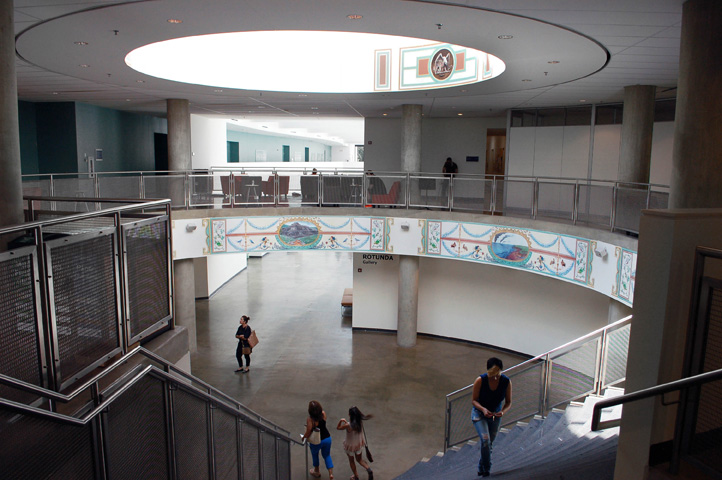 American Catastrophe Report on view at American University Katzen Arts Center August 2014 – August 2015.
For more information: http://www.american.edu/cas/katzen/calendar/?id=5706594
American Catastrophe Report on view at American University Katzen Arts Center August 2014 – August 2015.
For more information: http://www.american.edu/cas/katzen/calendar/?id=5706594
Artist Lauren Frances Adams has created American Catastrophe Report, an installation that acts as both homage and critique of the decorative frescoes in the United States Capitol Building, originally painted in the 19th c. by Italian-born artist Constantino Brumidi. The site-specific artwork by Adams is installed in American University’s Katzen Arts Center, in both the upper and lower rotunda in the center of the building, less than six miles from where Brumidi’s paintings are located. The prints forming American Catastrophe Report have the appearance of paintings due to the unique process Adams uses, where hand-painted originals are digitally scanned then printed for long-term public display. Adams updates Brumidi’s Capitol ornamentation by directly addressing ecological disasters in America that have been caused by human activities.
Visitors to the Katzen Arts Center will see an installation that is a mix of appropriated and invented imagery. Adams adapts Brumidi’s original frescoes in the U.S. Senate Wing that picture landscapes of the sparsely populated western states of the mid-19th century, as well as a variety of detailed images of birds. According to historians, Brumidi copied from lithographs in the Pacific Railroad Report and the Mexican Boundary Report, published in the 1850’s. It is possible that Brumidi’s incorporation of these landscapes were intended to not only celebrate scenic visions of America but also to promote a comprehensive identity of American geography and inevitable settlement. Further promoting specificity of place, the birds pictured in the Senate wing point to the importance of uniquely American subject matter in Brumidi’s efforts. Assistant curator for the Office of Senate Curator, Amy Elizabeth Burton, writes about the time capsule nature of the paintings, stating in the catalogue (published in 2014) To Make Beautiful the Capitol: Rediscovering the Art of Constantino Brumidi, “Brumidi’s birds reflect the 19-century surge in westward expansion and federal support for exploration and scientific discovery across the young and developing nation.”
Extending and celebrating this act of copying, Lauren Frances Adams has updated Brumidi’s masterful efforts with similar forms — landscapes and ornithological themes — but with a decidedly different artistic outcome. Reflecting a century and a half of human enterprise since Brumidi’s time, a selection of landscapes in decorative cartouches offers up these situations: Fracking (in rural Pennsylvania), the Great Pacific Garbage Patch, Mountaintop Removal Mining (in West Virginia), the Deepwater Horizon Oil Spill (in the Gulf of Mexico), and Climate Change (specified as glacial retreat in Alaska). Corresponding to each man-made ecological disaster, and pointing towards the totalizing effects of habitat destruction, pollution via chemicals and garbage, and changes in weather conditions, Adams has included several birds that represent the threats to fauna as environmental destruction advances: Scarlet Tanager, Bristle-Thighed Curlew, Cerulean Warbler, Brown Pelican, and the Tufted Puffin.
Other imagery present throughout the rotunda gives depth to the historical relationships between American citizens and our physical landscape. Acting as symbolic prescience, ornamental designs incorporate two birds distinctly absent from America today: the Carolina Parakeet and the Passenger Pigeon, both extinct. Decorative flora in the paintings incorporates kudzu, a non-native species that has caused widespread ecological damage in the United States. Lofted high above, two medallions face one another in the upper rotunda: a war-like eagle and a gentle lamb. Utilizing the neoclassical aesthetic employed by Constantino Brumidi (who was in turn inspired by ornamental Renaissance paintings in the Vatican), Adams incorporates uniquely American identifications, inviting visitors to the American University Katzen Arts Center to reflect upon the conundrum of the contemporary American condition visualized in American Catastrophe Report.
About the artist: Lauren Frances Adams mines the histories of power, labor, and visual culture to make surprising connections that resonate with current sociopolitical issues. She is a 2007 MFA graduate of Carnegie Mellon University, and lives and works in Baltimore, Maryland, where she is a full-time faculty member in painting at the Maryland Institute College of Art. She has had recent solo exhibitions at Back Lane West, Cornwall, UK; Contemporary Art Museum St. Louis; EXPO Chicago; Conner Contemporary, Washington, D.C. and Royal NoneSuch Gallery, Oakland, California. Her work has been featured in group exhibitions including: The Walters Art Museum (as a finalist for the Sondheim Prize) in Baltimore, MD; Nymans House and Gardens, Sussex, UK; CUE Foundation, New York; Mattress Factory, Pittsburgh, PA; and the Andy Warhol Museum, Pittsburgh, PA; among many others. She has been awarded Cité Internationale des Arts in Paris residency, Skowhegan School of Painting and Sculpture residency, and she is a Joan Mitchell Foundation MFA Grant recipient. Adams is the co-founder of Ortega y Gasset Projects, a gallery and long-distance artist collective in Bushwick/Ridgewood neighborhood in Queens. For more information, visit her website at http://www.lfadams.com.
For further press inquiries, contact the artist directly: laurenfrancesadams@gmail.com
The artist would like to thank the faculty and staff at American University who made the installation possible, including: Professor Zoë Charlton, Professor Tim Doud, Facilities Manager Jason Lurie, Installation team Bonner Sale and Zac Willis, the print center technicians at MICA, and especially The Clark Hulings Fund.
]]>